REALSPACE | Press page
An Art and Science Collaboration
Alyce de Roulet Williamson Gallery,
Art Center College of Design
October 4, 2014 - January 18, 2015
Press Release:
REALSPACE
Explores Nature, Science
[Pasadena, California] — The painter Willem de Kooning once said that the idea of space "is given to the artist to change if he can." And of the real, Robert Rauschenberg opined that a painting "is more like the real world if it's made out of the real world." Space in painting is measured on a scale that begins with deep illusion depicting what appears beyond the window of the canvas, and moves successively forward to tangible real tactility in front of the canvas. Where an artist chooses to work on that illusion-to-reality scale can have meaning in and of itself, and the modern history of those choices can be viewed as a kind-of archeology of existential change. The exhibition REALSPACE, opening October 4 at Art Center College of Design's Williamson Gallery, is meant to reflect on how science intersects with that history. Real space is what science studies. Poeticized by artists throughout human history, the intractable reality of the natural world is examined by contemporary art and artifacts included in REALSPACE.
> Click here to read: REALSPACE exhibit essay on the art-science movement and the myth of the supernatural.
REALSPACE will be installed in the Williamson Gallery October 4, 2014 through January 18, 2015. The public is invited to an opening reception on Friday, October 3, from 7 to 10pm. Artists in the exhibition include Adam W. Brown and Robert Root-Bernstein, James Griffith, Dan Goods and David Delgado, Santiago Lombeyda, Rebeca Méndez, and Jennifer Steinkamp. Artifacts and writings by James Ferguson (1710-1776), William Herschel (1738-1822), and Isaac Newton (1642-1727), on loan from The Huntington Library, are also featured in the exhibition that combines works from contemporary art and from science. At its opening the exhibition will be accompanied by a 20-page free booklet and, later on, a 40-page catalogue.
Around five-hundred years ago, history shows a slow curve away from knowledge formulated around the supernatural and imaginary, and toward knowledge derived from the natural and scientific. The rate of scientific progress intensified as it reached the 1800s, and was reflected both directly and metaphorically by the art of that century. "Nineteenth-century art's deconstruction of illusion in pictorial space and its ultimate relocation of aesthetic experience in real space can be viewed as a metaphor for simultaneous changes taking place in the humanities, sciences, and technology. It helped create a cultural weltanschauung, a world view shaped by the gradual decline of supernatural theories about the world (analogous to paintings depicting things in illusory space) and the rise of scientific ones (analogous to paintings becoming objects themselves in real space)," says Stephen Nowlin, Williamson Gallery director and the curator of REALSPACE.
"This emerging view continued to evolve through various channels in 20th century art and into the 21st century, and can be interpreted as having done its part to undermine the dualistic assumption that material nature and a magical supernature co-exist. This is, in retrospect, one of the more profound and under-heralded epistemological contributions made by late 19th and early 20th century art. The erosion of illusion in painting that accompanied a movement toward the concrete in painting, symbolized the general erosion of confidence in the supernatural brought about by the advancement of science."
Toward the end of the 20th century, technology and science joined earlier artistic movements as a new and inevitable means by which art could continue its foray into the aesthetics of the real. The increasing gravitation to science by artists and curators over the first decade of the 21st century, and the proliferation of art/science-related non-profits, galleries, and university programs worldwide, underscore the continuing inclination of many artists to wrestle resonant, poetic, and provocative content from the scientific world view, continuing the exploration of real space aesthetics begun almost two centuries ago.
Works in REALSPACE include: paintings from James Griffith's Natural Selection series, rendered using tar from the La Brea Tar Pits; Rebeca Méndez's large-scale video CircumSolar, Migration 3, 2013, an Icelandic documentation of her ongoing research on the migration of Arctic Terns; Jennifer Steinkamp's architectural projection 6EQUJ5, 2012, a reflection on the panspermia theory of life's introduction to planet Earth; Santiago V. Lombeyda's Expressive Maps, 2013, prints on vellum derived from DNA; the artist/scientist duo Adam W. Brown and Robert Root-Bernstein's Origins of Life: Experiment#1, 2010-2014, a re-imagining of the famous 1950s experiments of Stanley Miller and Harold Urey that mixed the primordial conditions of Earth in test tubes, which in turn produced chemical building blocks of life; and Dan Goods/David Delgado's installation Refraction, exploring the optical science and aesthetics of light and space. Among additional included works are a stunning group of astronomical engravings from the 1806 book Astronomy Explained Upon Sir Isaac Newton's Principles by astronomer, instrument and globe-maker James Ferguson; excerpts from the 1925 silent movie Wunder der Schöpfung (The Wonder of Creation); and haunting imagery encircling the asteroid Vesta as seen from NASA/JPL's orbiting Dawn spacecraft.
To artists engaged in exploring art and science, the border between those two domains is meandering and porous, inherently resistant to being defined as a firm property-line. Far from the clichéd view that science is an emotionally sparse and strictly diagrammatic view of existence, and that art is a pleasurably therapeutic escape from the straightjacket of rigorous endeavor, the so-called ArtSci movement searches for the two domains' truer and overlapping realities. "Science enjoys a popular patina of certainty which, however, conceals a process of groping and foraging, being messy, and tentative -- while behind the veil of art's seemingly cavalier processes and sensual indulgences, there is in fact cerebral order, structure, and intent," says Nowlin. "The true kinship of art and science is to be found outside the persistence of those stereotypes thought to separate them, and instead in the spark of insight that can result when each discipline is allowed and encouraged to ignite the other."
REALSPACE is a partner project of AxS 2014: Pasadena Festival of Art and Science, September 19 — October 5, 2014; organized by the Pasadena Arts Council. axsfestival.org
The Alyce de Roulet Williamson Gallery at Art Center College of Design is located at 1700 Lida Street in Pasadena; hours are noon to 5 p.m., Tuesday through Sunday, with extended hours on Fridays, until 9 p.m. The gallery is closed Mondays and holidays. For more gallery information, call (626) 396-2446.
Williamson Gallery exhibitions are funded in part by the Williamson Gallery Patrons and a grant from the Pasadena Art Alliance.
A Google index of links to Williamson Gallery art-science activities can be found at williamsongallery.net/google.
About the Alyce de Roulet Williamson Gallery
The Alyce de Roulet Williamson Gallery at Art Center College of Design has established a broad reputation for its ongoing series of exhibitions exploring the boundaries, relationships, and perspectives of art, design, and science. Recent exhibitions include FOLDED: The Origami Art of Robert J. Lang, a survey of folded paper, mathematics, and computer coding; Ray Eames: In the Spotlight, a retrospective of the work of Ray and her contribution to the Charles and Ray Eames legacy; PAGES, 2013, examining the page as a space for communicating as well as forging new ideas; WORLDS, 2012, a perspective on Earth and the Solar System; ENERGY, 2010, a composite exhibition of objects and artifacts addressing the poetry of natural forces; TOOLS, 2009, focusing on artifacts from the artificial extension of human biology; OBSERVE, 2008, a collaboration with the NASA/JPL Spitzer Science Center; In the Dermisphere, 2007, surveying the art and natural history of skin; EAR(th), 2004, a sound installation with artist Steve Roden and Caltech geophysicist Mark Simons; and NEURO, 2003, an art and science collaboration with the Center for Neuromorphic Systems Engineering, Caltech.
About Art Center College of Design
Founded in 1930 and located in Pasadena, California, Art Center College of Design is a global leader in art and design education and the first design school to receive the United Nations' Non-Governmental Organization (NGO) status. Art Center offers bachelor's degrees in advertising, entertainment design, environmental design, film, fine art, graphic design, illustration, photography and imaging, product design, and transportation design. A graduate program of study can lead to a master's degree in art, broadcast cinema, industrial design, and media design. The college also offers a series of programs for the general public, including Art Center at Night for continuing studies program; Saturday High for high school students; Art Center for Kids for children in the fourth through eighth grades; and the Design-Based Learning program for K-12 educators.
Exhibition dates:
October 4, 2014 - January 18, 2015
Opening reception:
Friday, October 3, 7-10pm
Admission free
Williamson Gallery hours:
Tuesday through Sunday, 12 noon to 5 p.m.
Friday, 12 noon to 9 p.m.
Closed Mondays and holidays
Alyce de Roulet Williamson Gallery
Art Center College of Design
1700 Lida Street
Pasadena, California 91103-1999
(626) 396-2397
for more information, contact
Teri Bond
Director, Media Relations
Art Center College of Design
(626) 396-2385
teri.bond@artcenter.edu
> Visit the REALSPACE website
> Link to other Williamson Gallery art-science projects
Download High-Res Images

Entryway, REALSPACE exhibit. Photo: Chuck Spangler.
> Download high-res Entryway, REALSPACE exhibit image
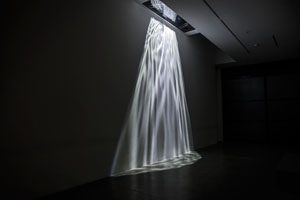
Dan Goods and David Delgado
Refraction, 2014; Theater light, water, custom electronics
19 x 25 ft., dimensions variable. Courtesy of the artists. Photo: Stephen Nowlin.
> Download high-res Refraction image
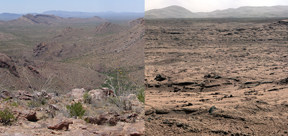
Stephen Nowlin
Planets 3 & 4
20-inch screen; Terrestrial and extraterrestrial photographs, web browser, custom scrolling code.
Left: EARTH Bull Pasture from the end of the trail, Organ Pipe Cactus National Monument, Arizona, USA,Earth; Photo courtesy of The National Park Service.
Right: MARS Curiosity MastCam at Rocknest, looking toward Point Lake, Mars; Photo courtesy of NASA/JPL-Caltech/MSSS
> Download high-res Planets 3 & 4 image
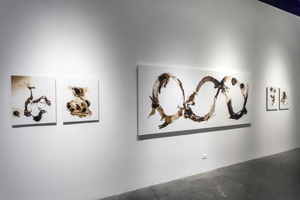
James Griffith
NATURAL SELECTION series, 2012
Tar on panels. 24x18 in.
Courtesy of the artist. Photo: Chuck Spangler.
> Download high-res NATURAL SELECTION: series image
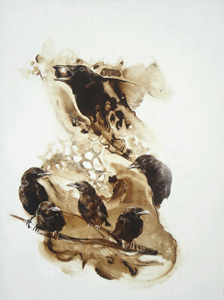
James Griffith
NATURAL SELECTION: Crow's Nest, 2012
Tar on panel. 24x18 in.
Courtesy of the artist. Photo: James Griffith.
> Download high-res Crow's Nest image. Photo: James Griffith.

James Ferguson
Astronomy explained upon Sir Isaac Newton's Principles, 1756
Original book (pedestal), reproductions of book engravings (walls).
Courtesy of The Huntington Library. Photo: Chuck Spangler.
> Download high-res Ferguson/Isaac Newton installation image
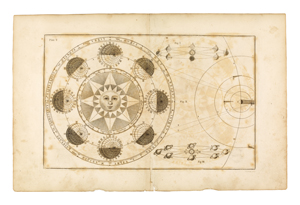
James Ferguson (astronomer), Daniel Lizars (engraver)
Planetary Phases from Astronomy explained upon Sir Isaac Newton's Principles, 1756
Engraving
Courtesy of The Huntington Library. Photo: Stephen Nowlin/Huntington Library.
> Download high-res Planetary Phases engraving image.
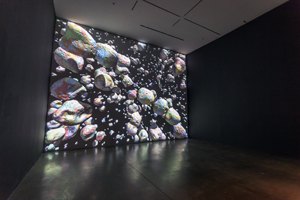
Jennifer Steinkamp
6EQUJ5, 2012
17 x 22 ft., dimensions variable
Courtesy of the artist, ACME, Los Angeles, greengrassi, London and Lehmann Maupin, New York. Photo: Chuck Spangler.
> Download high-res 6EQUJ5, image
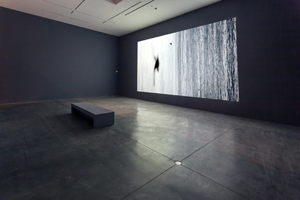
Rebeca Méndez
CircumSolar, Migration 3, 2013.
Single channel video with sound; 17 x 30 ft., dimensions variable.
Duration: 17min. - 46 sec. Still frame.
Sound by Drew Schnurr; Courtesy of the artist.
Photo: Chuck Spangler.
> Download high-res CircumSolar, Migration 3, image
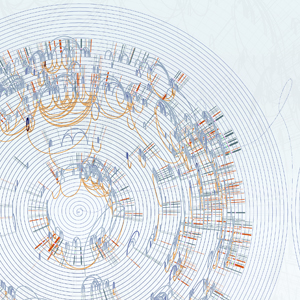
Santiago V. Lombeyda
Expressive Maps, 2013 (detail)
Three panels, 160in x 14in. each.
Contiguous visualization/ representation of complete mouse DNA sequence.
High-res giclee on vellum; Courtesy of the artist.
> Download high-res Expressive Maps, image
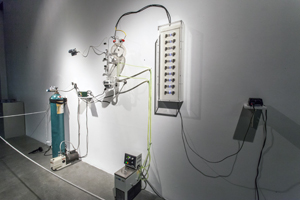
Adam W. Brown and Robert Root-Bernstein
Origins of Life: Experiment #1.x, 2010
Lab beakers, gas cannisters, chemicals, electronics
72 x 120 in., dimensions variable.
Courtesy of the artists. Photo: Chuck Spangler.
> Download high-res Origins of Life: Experiment #1.x image